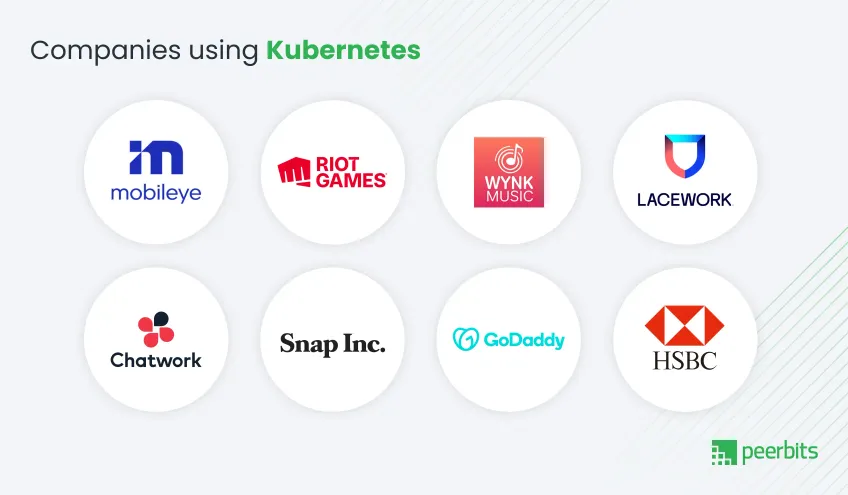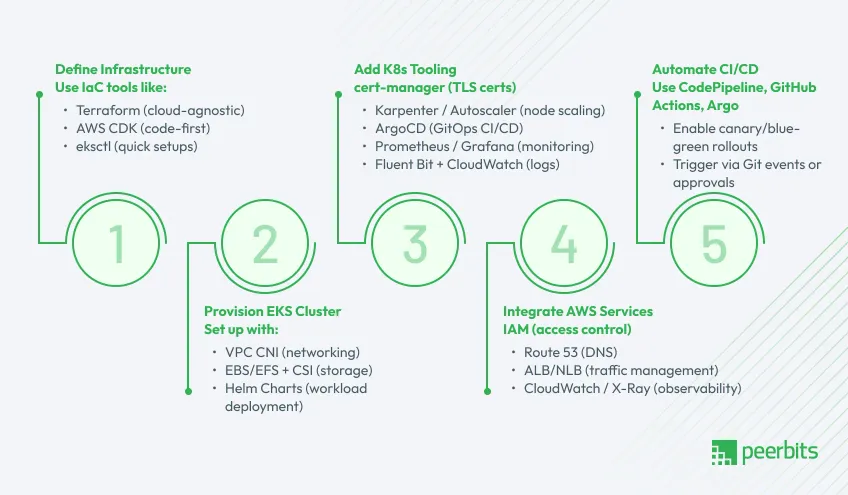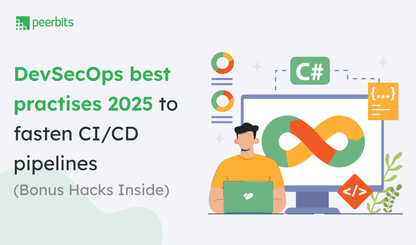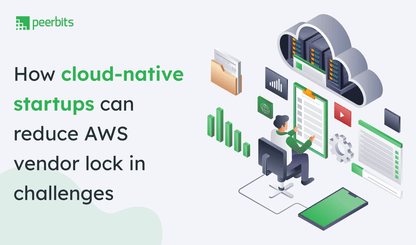In today’s era, automation is king of the market. From your food orders being automatically assigned for delivery to your Netflix & social media feeds automatically serving content based on your behavior, everything is automated now.
But without reliable management, the entire heaven of automation can turn into hell in seconds. That’s where Kubernetes with AWS EKS comes in.
Kubernetes, the open-source platform designed to automate the deployment, scaling, and management of containerized applications, is powerful but complex. Amazon Web Services (AWS) simplifies this complexity through Amazon EKS, its fully managed Kubernetes service, offering all the benefits of Kubernetes in a far more structured and enterprise-ready format.
But adopting Kubernetes with AWS EKS isn’t always easy. Many teams run into struggles like
Why can’t I connect to my EKS cluster?,
Do we even have the manpower to maintain this?”,
or the classic “Why does everything break after an upgrade?
Yes, there are other orchestration options out there, but if you're here, that means you're likely trying to make Kubernetes work the right way.
Before going deeper into challenges of Kubernetes integration with AWS EKS, let’s see why Kubernetes matters for your business.
Why your business need Kubernetes?
According to the CNCF 2024 report, over 96% of organizations are running container workloads with Kubernetes already in their production environments.

Companies like Mobileye, Riot Games, Wynk Music, Lacework, and Chatwork already use Kubernetes with AWS EKS migration to manage massive workloads, scale efficiently, and reduce operational costs.
Surely, Kubernetes is not just a trend; it's the engine behind modern software infrastructure. Here’s how it powers your business :
-
Scales effortlessly with demand Whether it's 100 users or a million, Kubernetes can scale your app infrastructure without breaking a sweat.
-
Apps run even in failed systems With built-in self-healing of Kubernetes, failed containers are automatically restarted or replaced, keeping downtime to a minimum.
-
Automates & handles it all From deployments to rollbacks and resource allocation, Kubernetes handles everything behind your software's functioning, leaving your team stress-free.
-
Infrastructure setup ease Kubernetes is designed for cloud-native architecture, it works seamlessly across cloud providers, on-prem, or hybrid setups.
-
Speeds up development & delivery Faster testing, deployment, and iteration cycles with Kubernetes allow your dev teams to ship features and updates faster.
-
Improves resource efficiency Kubernetes optimizes how your infrastructure resources are used, helping reduce cloud waste and keeping cost increases at bay.
But Kubernetes is open-source, so can’t people just manage it on their own? Do I really need a cloud provider like AWS?
Let’s break that down and see why many teams still choose AWS cloud computing services to utilise the benefits of AWS EKS over fully managed Kubernetes setups.
AWS EKS: What it is & How to integrate it?
Amazon EKS (Elastic Kubernetes Service) is a fully managed Kubernetes service offered by AWS. It handles the hard parts of setting up and operating the control plane, security patching, scaling, and availability in your automated systems.
For startups or enterprises modernizing from legacy systems, wAWS EKS migration is especially valuable. Instead of building everything from scratch. You can easily adopt cloud-native AWS EKS best practices with minimal overhead and get stronger integration with AWS services.
Here’s a simplified step-by-step guide to adopt Kubernetes with AWS EKS:

1. Define Your infrastructure
Use Infrastructure-as-Code tools like:
- Terraform – for cross-cloud flexibility
- AWS CDK – for developers who prefer code over YAML
- eksctl – for quick and easy EKS setups
These help you automate and version-control your cluster setup, making it easier to scale or rebuild as needed.
2. Provision the EKS cluster
Launch your cluster with the right configuration:
- Networking: Use Amazon VPC CNI plugin for pod-level networking
- Storage: Integrate with EBS or EFS using Container Storage Interface (CSI) drivers
- Workloads: Use Helm charts to deploy apps, configs, and infrastructure dependencies
3. Add Kubernetes-related tools
To run smoothly, you’ll want to install tools that improve performance and automation:
- Certified-manager – automates TLS/SSL certificate issuance and renewal
- Cluster Autoscaler or Karpenter – scales nodes automatically
- ArgoCD – for GitOps-based AWS EKS deployment and drift detection
- Prometheus/Grafana – for monitoring and alerts
- Fluent Bit/CloudWatch – for log aggregation
These tools are crucial for both lean startup teams and large enterprise DevOps pipelines.
4. Integrate core AWS Services
Kubernetes doesn’t live in a bubble. With EKS, you can easily connect to:
- IAM – Fine-grained access control to cloud resources
- Route 53 – DNS for service discovery
- ALB/NLB – Ingress and traffic management
- CloudWatch – Metrics, logs, and dashboards
- X-Ray – Distributed tracing for observability
If you're migrating from a legacy monolith, these integrations make your move smoother without losing security or performance visibility.
5. Automate CI/CD
For modern cloud teams, manual deployment is a bottleneck. With AWS EKS, you can:
- Build pipelines using CodePipeline, GitHub Actions, or Argo Workflows
- Automate canary or blue/green rollouts
- Tie AWS EKS deployments to Git events or approval workflows
That is a shortened version of the benefits of using AWS EKS for Kubernetes adoptions.
But how to fix issues that come during the integration of Kubernetes with AWS EKS? Follow further to find out.
Top 10 challenges & fixes in integrating Kubernetes with AWS EKS
Integrating Kubernetes with AWS EKS seems easier with all the automation and managed orchestration without the Kubernetes hair-pulling. But everything have its quirks, and if you’re stepping into this space, it's better to face the devils you can predict.
1. The “Where do I even start?” Problem
Kubernetes isn’t exactly plug-and-play, and neither is AWS. When you combine them, the initial setup can feel like wiring a jet engine mid-flight. Without a standardized setup, teams often end up writing conflicting Terraform scripts, duplicating IAM policies, and pasting Helm charts from three different Stack Overflow threads.
Fix: Use tools like AWS Blueprints, eksctl, or Terraform CDK to enforce a standardized way of spinning up clusters and dependencies. Automate bootstrapping with cert-manager, ArgoCD, autoscalers, and logging solutions.
2. Upgrades causing service disruption
AWS EKS does a great job of managing control planes, but upgrades, especially for worker nodes, can cause service disruption if not handled carefully. And as Redditors debated a lot on the mismatched AMIs or outdated Kubernetes versions, that nuked entire clusters.
Fix: Upgrade incrementally, one minor version at a time. Use separate node groups for canary testing, automate upgrade tests in staging, and schedule downtime windows. And above all, don’t wait three versions to catch up on the AWS EKS documentation.
3. Too many tools, not enough alignment
There are a dozen ways to solve every problem in Kubernetes, and “that’s also a problem”. Without governance, one team uses FluxCD, another uses ArgoCD, someone’s running Helm manually, and your monitoring dashboard is a mosaic of Prometheus, Datadog, and logs nobody checks.
Fix: Pick an opinionated stack and stick to it. For GitOps, pick either ArgoCD or Flux. For autoscaling, decide between Cluster Autoscaler and Karpenter. And yes, enforce those choices through documentation and CI rules. Governance isn’t optional; it’s what saves you from future Slack wars.
4. Lack of in-house expertise
This one’s brutal. Kubernetes isn’t something your average DevOps engineer picks up over a weekend, and AWS adds its own layer of complexity. When you deploy Kubernetes on AWS EKS without a platform team in place, don’t wonder why it’s on fire!
Fix: Either invest in building a cloud platform team or partner with an AWS cloud consulting service that specializes in EKS rollouts. For smaller businesses or early stages, Fargate offers a serverless on-ramp to reduce the operational lift.
5. Bills keep rising with time
AWS Bill increases are a major issue with organisations dealing with EKS. They usually come from idle EC2 nodes, improperly scaled workloads, forgotten test clusters, or running everything on on-demand instances.
Fix: Embrace Spot instances and Karpenter for dynamic autoscaling. Define resource requests/limits accurately. Use cost visibility tools like Kubecost or AWS Cost Explorer. And yes, tag everything, because when AWS support asks, you don’t want to guess what “eks-test-001” does.
Read more: How AWS Managed Services can help optimize your cloud costs?
6. IAM, networking, and policy nightmares
Kubernetes RBAC is confusing enough. Add AWS IAM roles, security groups, VPC networking, and OIDC trust policies, and you’re officially in acronym soup that no one understands.
Fix: Stick to IAM Roles for Service Accounts (IRSA), adopt the AWS VPC CNI plugin, and use fine-grained IAM policies with managed AWS add-ons. Use tools like eksctl and Terraform modules to bake in those policies automatically and avoid reinventing the wheel for every pod that needs S3 access.
7. Death by Helm charts and YAML spaghetti
Many teams describe their EKS setup as “a graveyard of Helm values files and forgotten Kubernetes manifests.” Redditors call it “a nested s***show of YAML and command-line flags.”
Fix: Create opinionated, reusable Helm charts for internal apps and services. Adopt GitOps with ArgoCD or FluxCD to centralize manifests and track drift. Version everything. Automate AWS EKS deployment pipelines. If your YAMLs are scattered across desktops, you’re one merge conflict away from disaster.
8. Sluggish Scaling and cold start times
Auto-scaling that lags by 10 minutes might be fine for dev environments, but it kills performance in production, especially for burst-heavy applications like real-time video processing or e-commerce flash sales.
Fix: Use Karpenter or the Cluster Autoscaler to intelligently scale based on demand. Keep a buffer of warm nodes in high-load environments. Monitor pod startup latency and fine-tune your node pool types.
9. GitOps branching mess
GitOps promises operational bliss, but without guidelines, teams end up creating conflicting branches, untracked overrides, and unsynced changes.
Fix: Set strict GitOps conventions. Structure your repos clearly and separate infra, apps, and environments. Enforce code reviews, automated PR checks, and sync strategies. And for heaven’s sake, label your Helm releases like a responsible adult.
10. Cluster drift and version skew
You start with good intentions, but soon one cluster is running v1.24, another is on 1.28, and no one knows why things randomly break.
Fix: Automate version checks, enforce upgrade schedules, and document your baseline cluster config in version-controlled templates. Use tools like kube-score, Polaris, and AWS Config, backed by an AWS Cloud Consulting Partner, to track and alert on drift. When things change, make sure it’s logged and reviewed, not whispered about in hallway chats.
AWS EKS deployment options
Now, being aware of all the challenges & fixes in AWS, the next struggle lies in AWS EKS deployment types to choose. Yes, they are more than one, and here’s a quick table to help you find the best fit without going through long AWS EKS documentation:
| Type | What it is | Best For |
|---|---|---|
| Standard EKS | Managed control plane on AWS; you choose EC2 or Fargate worker nodes. | Most businesses; maximum flexibility vs. complexity. |
| EKS on AWS Outposts | Run EKS on on‑premises hardware via Outposts, with consistent AWS/Kubernetes experience. | Hybrid deployments, strict latency/data residency. |
| EKS Anywhere | Install and run EKS on your own infrastructure (data center or on‑prem hardware) using same toolset. | Full control: no AWS dependencies; consistent UX. |
| EKS Distro | Open source Kubernetes distro identical to the one AWS uses, for deployment anywhere (incl. laptops). | Developers, testing, edge cases, offline environments. |
How AWS EKS pricing is calculated?
AWS EKS pricing structure has three main components:
1. Control Plane Fee – $0.10/hour per cluster ($73/month).
2. Worker Nodes – EC2 or Spot hourly rates; or Fargate per-pod pricing.
3. Add‑On Costs – Associated AWS services like EBS, ELB, CloudWatch, VPC data transfer, autoscaler overhead, and monitoring.
For further details, you can also get your custom cost estimate of AWS EKS pricing with Amazon’s very own cloud calculator.
Cost optimization tips:
- Use Spot instances + Karpenter for dynamic scaling.
- For smaller workloads or unpredictable scale, Fargate may reduce ops burden at a slight premium.
- Build deployment guardrails to avoid zombie clusters and idle nodes.
- Centralize logging and metrics to spot inefficiencies via CloudWatch or DataDog.
Conclusion
Integrating Kubernetes with AWS EKS is not just a technical choice; it’s a strategic investment for businesses growing in scale, speed, and complexity. But it comes with real challenges: tooling sprawl, upgrade chaos, cost unpredictability, and staffing gaps.
With 10+ years of hands‑on cloud and DevOps experience, I can tell you this: you solve these challenges by treating EKS not as a one‑off install, but a platform. Standardize your stack—Terraform, eksctl, or CDK; GitOps workflows; autoscaling managed via Karpenter; consistent cluster upgrades; cost governance.
If you're a cloud‑savvy decision maker... You don't just want Kubernetes, you want Kubernetes with AWS EKS done right. That means fewer late‑night pagers, more predictable releases, and happier developers.
Thinking about adopting EKS? Let's talk about how to get the foundation rock solid so your teams focus on differentiation, not YAML quirks.

FAQs
It’s often due to IAM role issues or VPC misconfigurations. Update kubeconfig, check IRSA settings, and verify security group and subnet rules.
Upgrade in small steps, test in staging first, and use separate canary node groups to limit production risk.
Use IAM Roles for Service Accounts (IRSA), the AWS VPC CNI plugin, and manage policies with Terraform or eksctl templates.
Take advantage of Spot Instances, set accurate resource requests/limits, and track usage with Kubecost or AWS Cost Explorer.
For most teams, EKS reduces operational burden with managed upgrades, better AWS integration, and 24/7 reliability.
Standardize your GitOps workflow, autoscaling method, and Helm charts. Keep all manifests versioned in a central repo.








